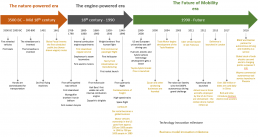Are we heading toward a world where mobility in cities is convenient, affordable, safe, and environmentally sustainable? Or congested, expensive, risky, and polluting?
Mobility has been on a steady growth path for many years. Technology innovation transformed mobility between the 18th and early 20th century. With the second industrial revolution, moving people and goods around became more efficient. More people could afford to move, but the engine of moving around has not changed.
That is literally because the combustion engine has dominated transportation. The growth in private vehicle ownership and collective transportation services operated by large monopolies or oligopolies (such as airlines, railways, and public transit) is still the primary business model.
But the negative aspects of this mobility model (pollution, congestion, traffic fatalities) are hindering social and economic development around the world.
The challenges of mobility coincide with the development of technological advances. Electric mobility, autonomous driving, and digital services are converging with alternative business models such as ride-hailing, ride-sharing, micro-mobility, and demand-based transit to create new opportunities.
The clash of mobility challenges and innovations can turn mobility into a force of progress and happiness once again. Singapore’s transport minister, Khaw Boon Wan, speaking at the ITS 2019 opening ceremony, said:
“I look beyond the technology element. What matters is that we have a transport system that is fast, safe, reliable, and, very importantly, affordable for all people.”
Possible Future Scenarios of Mobility
The future of mobility will not be determined by a single factor. It will be the combination of societal, technological, economic, environmental, and political megatrends that will reshape how people and goods move in cities and beyond.
How these trends interplay between 2020 and 2030 will determine demand for people and goods mobility — whether it increases or diminishes, or how much individuals and organizations are free to choose when, where, and how to move.
The impact of this evolution will last for 30 years and more, just as the advent of the oil-fueled and car-based economy determined the past hundred years. The next 10 years will determine whether we will live in a world where mobility is convenient, affordable, safe, and environmentally sustainable — or one where it is congested, expensive, risky, and polluting. Four possible scenarios could unfold:
- Sustainable mobility. Sustainable mobility will result in safer roads, less pollution and congestion, and more road space given back to neighborhood living.
- Individualistic mobility. Individualistic mobility will result in lower pollution and safer roads, but also endless gridlock, so that people spend more and more time in their private vehicles.
- Utilitarian mobility. Utilitarian mobility will result in most people enjoying safer roads, and less pollution and congestion, but being subject to strict surveillance and limitations on their mobility choices.
- Elite mobility. Elite mobility will result in most people enjoying lower pollution but being forced to move less and experience endless gridlock.
Impacts Across the Mobility Ecosystem
Transportation companies, governments, vehicle OEMs, retailers, insurance companies, information and operational technology suppliers, and other organizations that will be impacted by the changes in mobility in the next 10 to 20 years must prepare now. They must understand how three main attributes of people and goods mobility will vary among different scenarios:
- Experience: including planning, payments, navigation, on the move services, and loyalty programs
- Space: including vehicles, physical infrastructure, signaling and safety systems
- Ecosystem: including policymaking, revenue models, and data sharing
Organizations across the mobility ecosystem can choose to play an active role or wait until the transformation makes them obsolete. The organizations impacted by the future of mobility that do not consider these strategic implications will not get their expected financial return on technological innovation. And they will be buying hyped products that are immature and therefore come with safety, financial, and reputational risks.
To learn more, please contact Max Claps or drop your details in the form on the top right.


